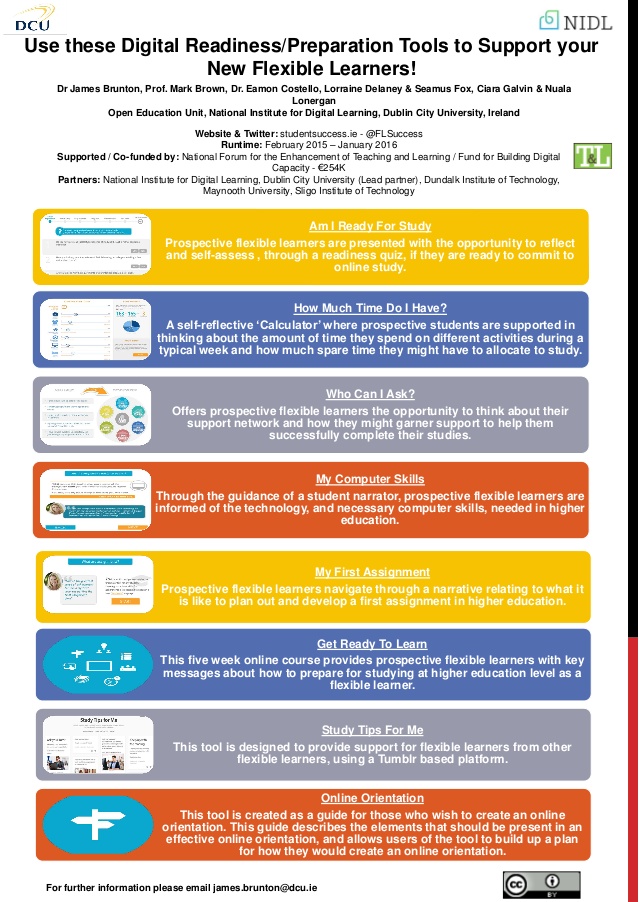Student success: Difference between revisions
Jump to navigation
Jump to search
(Created page with "{{stub}} == Introduction == == Improving student success == A first strategy is to help transition, e.g. make sure that a learner will be able to cope with a new type of env...") |
|||
| Line 6: | Line 6: | ||
A first strategy is to help transition, e.g. make sure that a learner will be able to cope with a new type of environment (e.g. moving from high school to university). | A first strategy is to help transition, e.g. make sure that a learner will be able to cope with a new type of environment (e.g. moving from high school to university). | ||
[[File:use-these-digital-readinesspreparation-tools-to-support-your-new-flexible-learners-1-638.jpg|thumb|none]] | The team from the [ Student success] project created a poster with the following objective: | ||
{{quotationbox|This poster presents a suite of openly available digital readiness/preparation tools, created by the Student Success Toolbox project, which can be used by programme teams/institutions, to address the problem of effective flexible learner transitions into Higher Education (HE), during the study-lifecycle’s initial stages. Flexible learners are defined, here, as adults engaged in part-time or online/distance-learning. Enhancing retention and completion rates of this group is a problem both globally and within the Irish context. Method: This poster presents a summary of how each tool can be utilised, along with links to further online information, along with the tool itself. Result: Eight tools havebeen created, based on an analysis of existing literature and tools used internationally, along with a guide to supporting new flexible learners, which will inform institutions/discipline teams on how to effectively deploy these tools. This poster aids in the dissemination of the tools, and related guide, as well as highlighting other dissemination events. Conclusion: This project provides resources to institutions/discipline teams to help them support flexible learners through key transitions in the early stages of the study-lifecycle.}} ([https://www.slideshare.net/JamesBrunton/use-these-digital-readinesspreparation-tools-to-support-your-new-flexible-learners Use these Digital Readiness/Preparation Tools to Support your New Flexible Learners!], retrieved March 1, 2017) | |||
[[File:use-these-digital-readinesspreparation-tools-to-support-your-new-flexible-learners-1-638.jpg|thumb|800px|none]] | |||
Revision as of 23:32, 1 March 2017
Introduction
Improving student success
A first strategy is to help transition, e.g. make sure that a learner will be able to cope with a new type of environment (e.g. moving from high school to university).
The team from the [ Student success] project created a poster with the following objective:
This poster presents a suite of openly available digital readiness/preparation tools, created by the Student Success Toolbox project, which can be used by programme teams/institutions, to address the problem of effective flexible learner transitions into Higher Education (HE), during the study-lifecycle’s initial stages. Flexible learners are defined, here, as adults engaged in part-time or online/distance-learning. Enhancing retention and completion rates of this group is a problem both globally and within the Irish context. Method: This poster presents a summary of how each tool can be utilised, along with links to further online information, along with the tool itself. Result: Eight tools havebeen created, based on an analysis of existing literature and tools used internationally, along with a guide to supporting new flexible learners, which will inform institutions/discipline teams on how to effectively deploy these tools. This poster aids in the dissemination of the tools, and related guide, as well as highlighting other dissemination events. Conclusion: This project provides resources to institutions/discipline teams to help them support flexible learners through key transitions in the early stages of the study-lifecycle.
(Use these Digital Readiness/Preparation Tools to Support your New Flexible Learners!, retrieved March 1, 2017)
